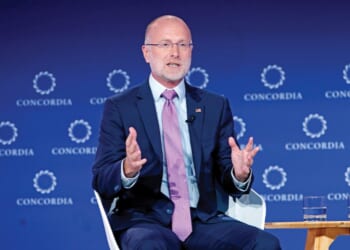President Donald Trump’s trade and foreign policies are shaking up the U.S.-dominated post-Cold War order. That troubles many allies, who worry that their economies will suffer as America withdraws from its security guarantees.
There’s one way, however, for these innovations to reassure allies on both counts: using the promised new investment in the United States from Trump’s trade deals to increase America’s defense industrial base. The details of the trade deals with Japan and South Korea are an excellent example of how this can work to increase America’s naval capacity dramatically.
The U.S. Navy has many problems. China’s navy now has more combat ships, although many are smaller and considered to be less advanced. Meanwhile, America’s fleet has aged as funds were diverted to anti-terrorism efforts during the War on Terror, while also failing to keep up with inflation.
At the same time, America has allowed its shipbuilding capacity to shrivel. The world’s largest economy only builds 0.1% of the world’s annual commercial ship production, roughly four ships per year.
America has retained some military shipbuilding capacity, but even this has shrunk sharply since 1989. The Navy now has only four shipyards capable of building its fleet. China has at least 35.
This means that planned increases in fleet size simply cannot take place at the speed defense planners want.
These shipyards also struggle to adhere to their agreed-upon timelines. The General Accounting Office reported last year that the planned construction of 13 new Arleigh Burke-class destroyers would likely be delayed for up to 25 months.
This is not an isolated example. Its new Constellation-class frigate program looks to be three years behind schedule, while the Virginia and Columbia-class submarine programs are also running well behind schedule.
Even routine maintenance is being delayed because of shipyard problems. A third of the country’s submarine fleet is unavailable at any time because it is either undergoing necessary maintenance or is idle, waiting for maintenance slots to open up in shipyards. That percentage has nearly doubled since FY 2015.
The Navy is investing in upgrading the shipyard capacity and technology, but it’s a case of too little too slowly. With China’s navy growing rapidly, admirals increasingly worry it might be too late.
American naval supremacy is essential to our allies, especially in the Pacific, because control of the seas allows military and merchant ships to travel unhindered. If China, for example, were to wrest control of the Western Pacific from allied forces, it could easily bring Japan, South Korea, and Taiwan to their knees simply by blockading their ports.
If the U.S. relied on its own resources, this problem might be solved before it’s too late. Fortunately, our allies can help.
Japan and South Korea have robust shipbuilding capacity, and even Europe has retained a significant ability to produce modern ships. Together, these allies produce nearly as many commercial ships as China while also maintaining small but significant military programs.
In short, they have the knowledge and the ability to help America address its long-standing woes.
It might be politically difficult for Trump to outsource American naval shipbuilding to foreign lands. Security risks would also surely increase when non-American workers have access to our most sensitive naval technologies. While Trump has sometimes floated that idea, it’s likely not to come to fruition.
But nothing stops these countries’ shipbuilders from coming to America. Under the right circumstances, they could strategically establish new shipyards on both coasts. Their up-to-date technology would vastly improve the aging equipment America’s dilapidated yards too often employ, while their modern know-how could easily cut delays sharply.
One challenge is financing this construction, another is training the skilled workforce, and a third is ensuring sufficient work to make construction economically viable. Trump can address all three challenges, though, if he’s willing to use a key provision in his trade deals as leverage.
Each deal requires the allied signatory to commit to at least a minimum level of additional investment within the United States above its current levels. The combined amount is staggering: $1.4 trillion.
The Japanese and South Korean deals also require that the investments be deployed on projects that Trump personally approves. This gives him the leverage to direct investment in projects essential to national security, such as building new shipyards.
That’s exactly what Trump should do. In consultation with relevant governments and shipbuilders, he should direct investment into the rehabbing, upgrading, and ideally creating shipyards devoted to military production.
Firms won’t make those investments without expecting future profits, but Trump can solve that obstacle, too. As these deals come to fruition, he and Defense Secretary Pete Hegseth should sign contracts awarding the relevant shipyards the right to build and/or maintain a set level and type of Navy ships.
These contracts need to be for the long term and subject to the minimum amount of congressional change possible. Both conditions would ensure that the firms would see a healthy return on their investment.
The AUKUS deal signed by President Joe Biden exemplifies what could be directed to these new shipyards. That arrangement provides that the U.S. will sell Australia up to five older Virginia-class nuclear attack submarines after 2032. Recall, however, that the American plan to acquire more of these vessels is already years behind schedule.
Fulfilling the AUKUS obligation under these conditions may simply mean the United States reduces the number of its submarines on active duty. That’s not in America’s interests and is perhaps one reason why the Defense Department is currently reviewing the AUKUS deal.
Trump could solve that problem by establishing a new shipyard with trade deal investment funds to build America’s new Virginia-class submarines. That would increase our insufficient submarine production, thereby allowing America to transfer its older subs to Australia under the deal, increasing the Allied ability to oppose Chinese expansion.
These deals could also allocate expected future ship construction plans to the new shipyards. The Navy is currently in the design phase of its DDG(X) program to build a new class of destroyers. New shipyards could be given contracts to build this ship. They could also be given the ability to enter into future design contracts as the Navy inevitably seeks to upgrade its designs for platforms across the fleet.
Foreign firms will also hesitate to commit funding as long as America’s shortage of skilled workers continues. Trump can help meet that concern by creating new federal programs specifically targeted to attract, train, and retain Americans committed to becoming shipbuilders.
Such a program can go far beyond traditional, similar programs. They could offer perks that would be attractive to young people, such as guaranteed housing down payments or favorable home lending rates upon completion of a certain number of years working at the yards. The federal government could also pay relocation expenses, which the individual worker typically shoulders.
These examples merely show what could be done if Trump’s team imaginatively works to solve this pressing problem.
These new shipyards would essentially be military versions of the transplant auto factories that now build roughly half of America’s cars and trucks. Foreign car firms now operate 24 of these plants in America, often shipping parts constructed in their own countries to be assembled in the United States.
Transplant factories are a classic win-win arrangement. Americans get jobs in the plants and factories built to supply parts, not imported from overseas. Foreign nations have jobs at home supported, both in the design of the cars and in producing the parts exported for assembly. They also benefit from the profits that can be shipped back home for investment.
STATE DEPARTMENT RELEASES FIRST HUMAN RIGHTS REPORT AFTER RESHUFFLING
The shipyard deals would operate in the same way. South Korean, Japanese, and European shipbuilders would get jobs and profit at home, while Americans would get good-paying jobs for their citizens and a dramatically improved navy. The improved navy would also benefit all nations as it would increase deterrence and make it likelier that America remains able to fulfill its defense commitments to our allies.
At its core, Trump’s “Make America Great Again” vision promises a nation that once again is the most powerful industrial nation in the world, coupled with a military large enough and strong enough to prevent any competitor nation from rationally seeking conflict. Combining his trade vision with his military to leverage allied funds and expertise to expand America’s defense industrial base and military will do just that.

















